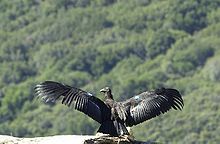Busy with dinghies, computer/internet shit,
Re potted Annabel with fresh soil (she wasn't doing well in the sand from a beach in SXM)..
Reorganized interior again so getting to the hydraulic steering shit soon....
Time.. 18.01
BOYO behind me..
Got a dying dinghy (big leak and old) and other one had a (very small) leak, hope that is fixed now...
rolly swell outside due to Isaac, so went in to change engine etc..
Bye bye SXM (Sept 2nd time 06.50)..
Wanted Yellow fin Tuna for breakfast, but also this bait with steel wire disappeared totally.. Fish I'm catching are to big..
After hydraulics were gone I rolled the jib away 80% at night and let the main out..
This way Condor stayed on course (slow) so I got some sleep..
Big..
Condor (Wiki) is the common name for two species of New World vultures. The name derives from the Quechua kuntur.[1][2] They are the largest flying land birds in the Western Hemisphere.
They are:
- The Andean condor (Vultur gryphus) which inhabits the Andean mountains.
- The California condor (Gymnogyps californianus) currently restricted to the western coastal mountains of the United States and Mexico and the northern desert mountains of Arizona in the United States.
The adult plumage is uniformly black, with the exception of a frill of white feathers nearly surrounding the base of the neck which are meticulously kept clean by the bird. As an adaptation for hygiene, the condor's head and neck have few feathers, which exposes the skin to the sterilizing effects of dehydration and solar ultraviolet light at high altitudes. The head is much flattened above. In the male it is crowned with a caruncle or comb, while the skin of the neck in the male lies in folds, forming a wattle. The skin of the head and neck is capable of flushing noticeably in response to emotional state, which serves to communicate between individuals.[citation needed]
Andean Condor soars over southern Peru's Colca Canyon
Immature California Condor..
Although it is on average about five cm shorter from beak to tail than the California condor, the Andean condor is larger in wingspan, ranging from 274 to 310 cm (8.99 to 10.17 ft)[5] and heavier, reaching up to 11 to 15 kg (24 to 33 lb) for males and 7.5 to 11 kg (17 to 24 lb) for females.[6] Overall length can range from 117 to 135 cm (46 to 53 in)[7] Measurements are usually taken from specimens reared in captivity.[5]
California condors' wingspan measures up to 2.9 m (9.5 ft), and they can weigh up to 10.4 kg (23 lb). The skin on the necks will vary in color, depending on the age of the birds. Adult birds' skin color can range from cream, pink, yellow, or even orange during breeding season.
Fossil record
Fossils from the Pleistocene era have been found in various parts of North America, including New York and Florida, leading scientists to believe that California condors or their ancestors once lived on the west coast of North America as well as all the way to the eastern coast. Some scientists also believe that an ancient relative of the condor, Argentavis magnificens from South America, may have been the largest flying bird ever with a wingspan of 7 metres (23 ft).[8]Behavior
Sexual maturity and breeding behavior do not appear in the condor until 5 or 6 years of age. They may live for 50 years or more, and mate for life. The world's oldest condor died at 100 in the Jardin d'Essai du Hamma in Algiers.[9]The young are covered with a grayish down until they are almost as large as their parents. They are able to fly after six months, but continue to roost and hunt with their parents until age two, when they are displaced by a new clutch. There is a well-developed social structure within large groups of condors, with competition to determine a 'pecking order' by body language, competitive play behavior, and a wide variety of vocalizations, even though the condor has no voice box.
On the wing the movements of the condor are graceful. The lack of a large sternum to anchor correspondingly large flight muscles identifies it physiologically as a primary soarer. The birds flap their wings on rising from the ground, but after attaining a moderate elevation they seem to sail on the air.
Wild condors inhabit large territories, often traveling 250 km (160 mi) a day in search of carrion. They prefer large carcasses such as deer or cattle which they spot by looking for other scavengers, which cannot rip through the tougher hides of these larger animals with the efficiency of the larger condor. In the wild they are intermittent eaters, often going for a few days without eating, then gorging themselves on several kilograms at once, sometimes to the point of being unable to lift off the ground.














No comments:
Post a Comment